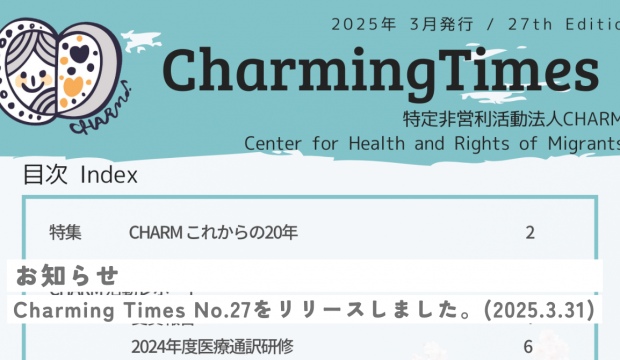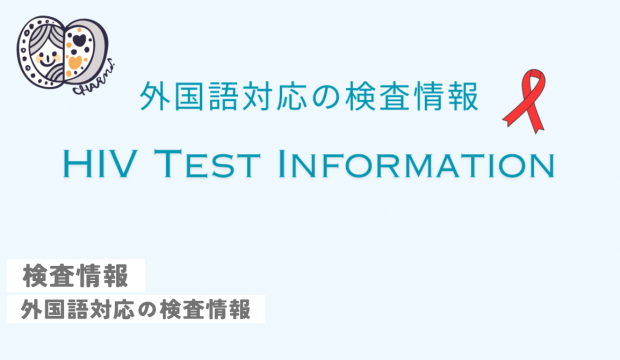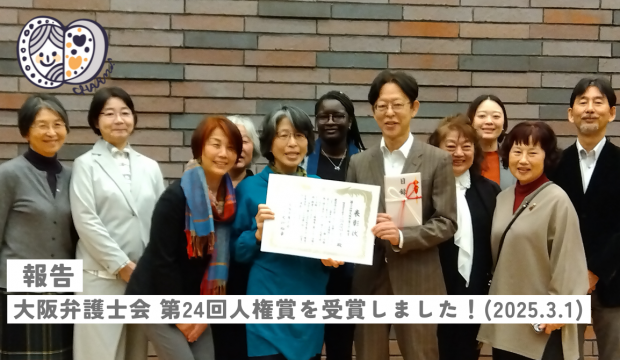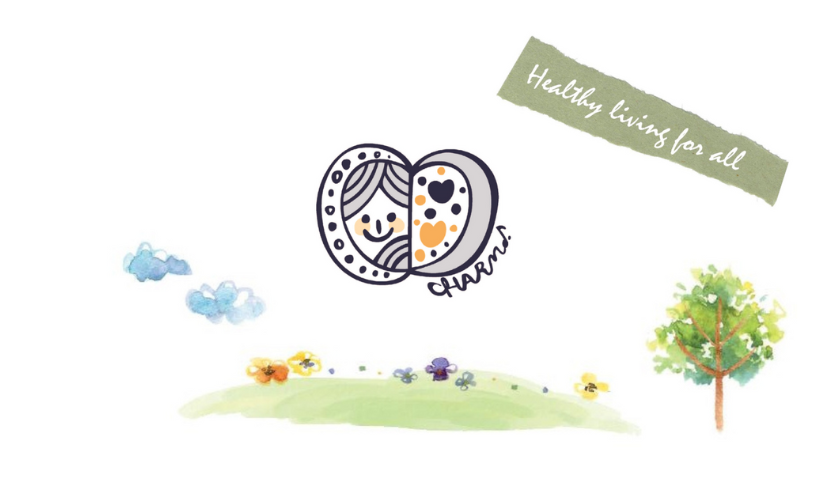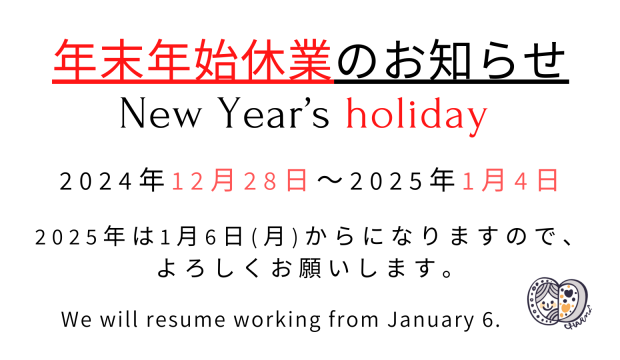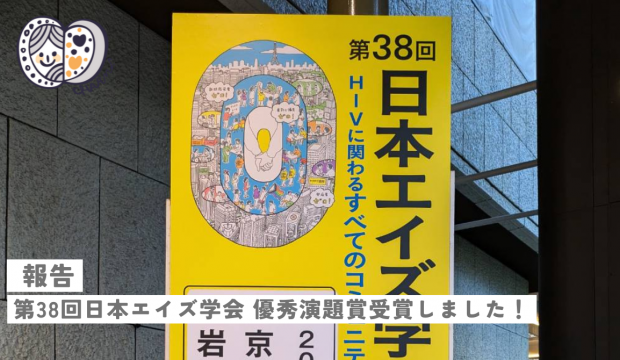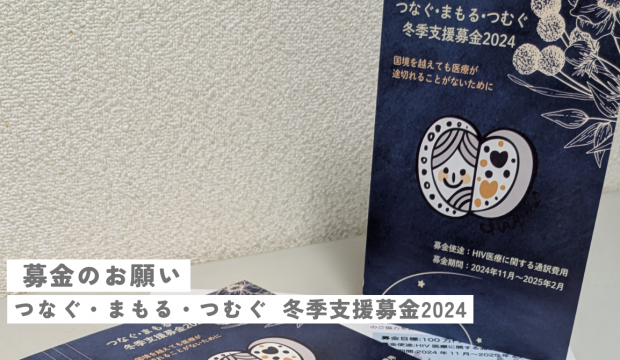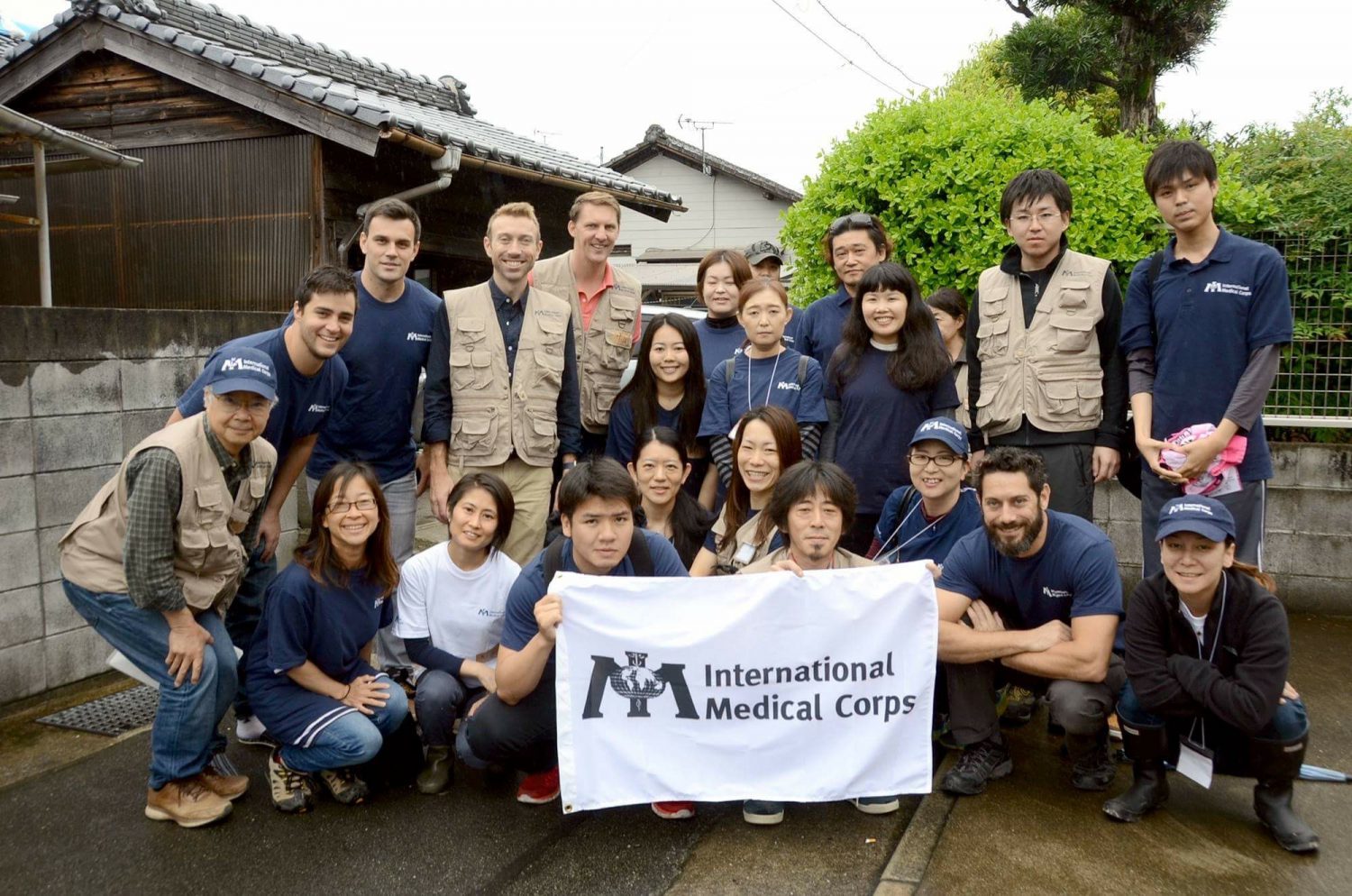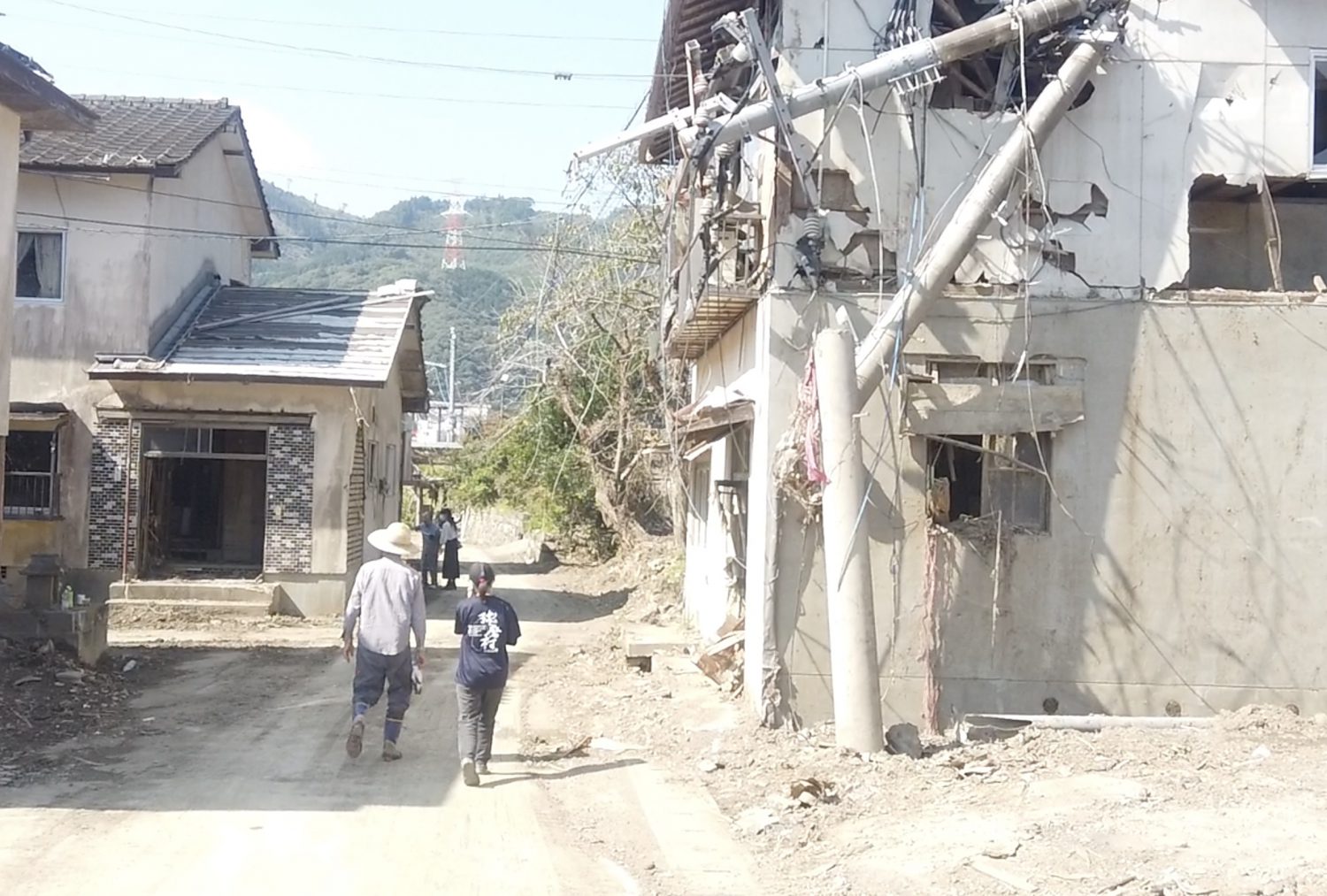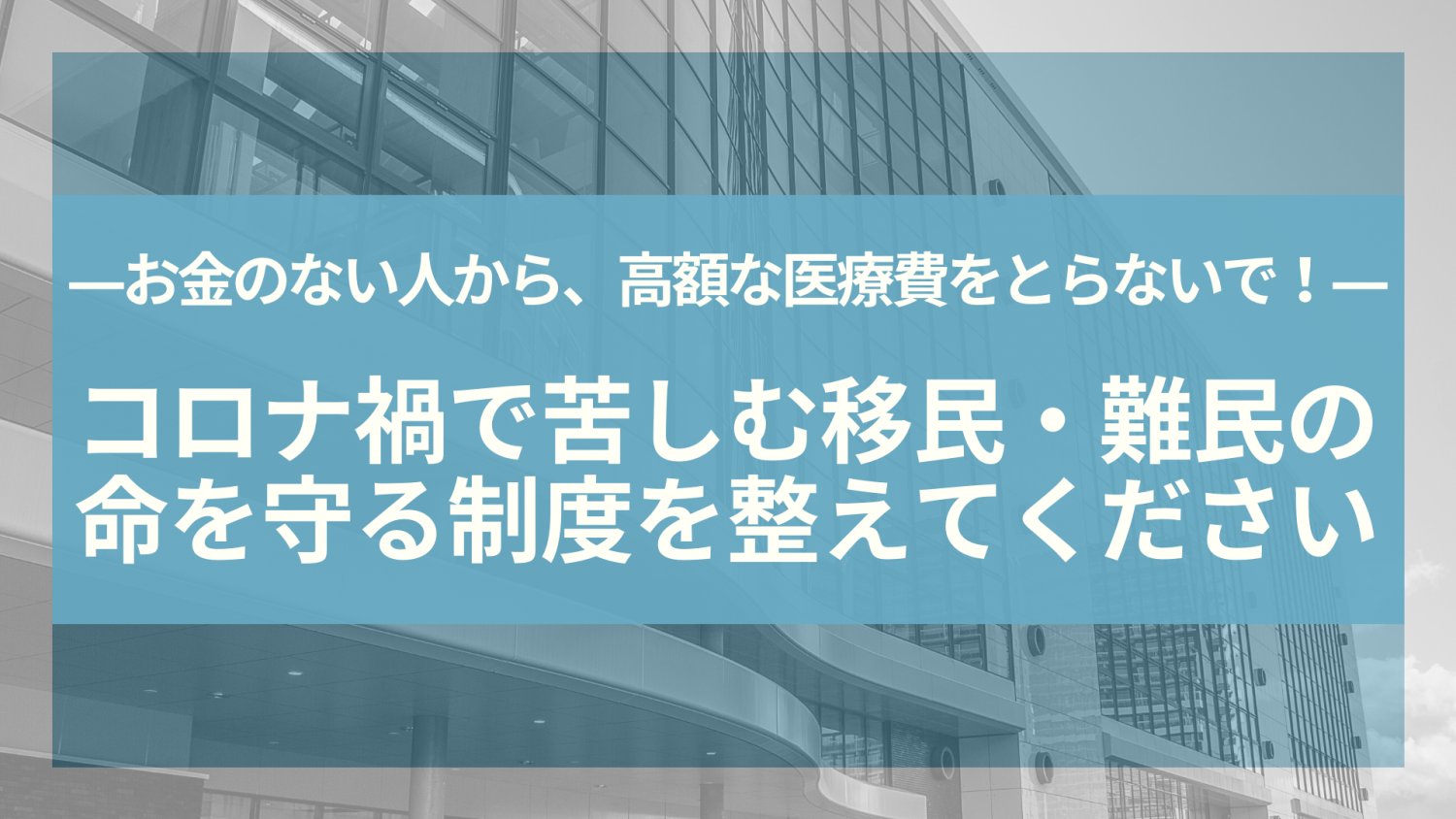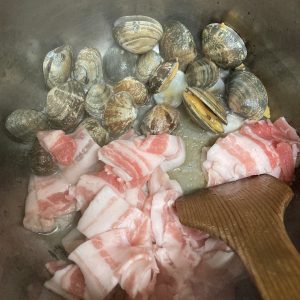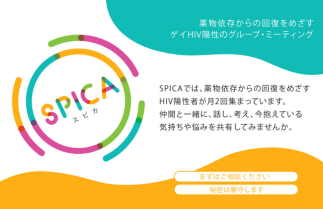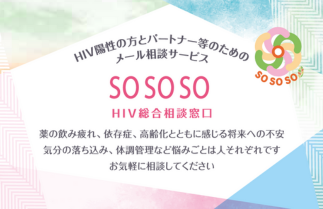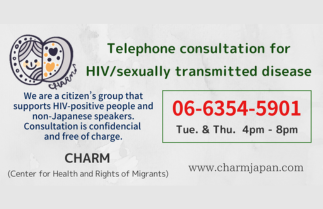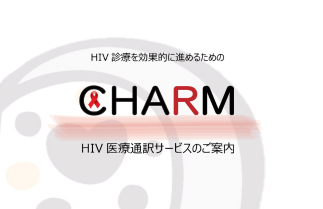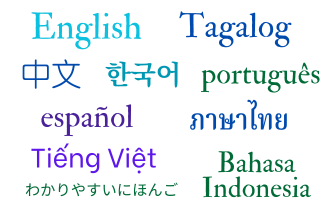<2021年12月発行 / 21st Edition>
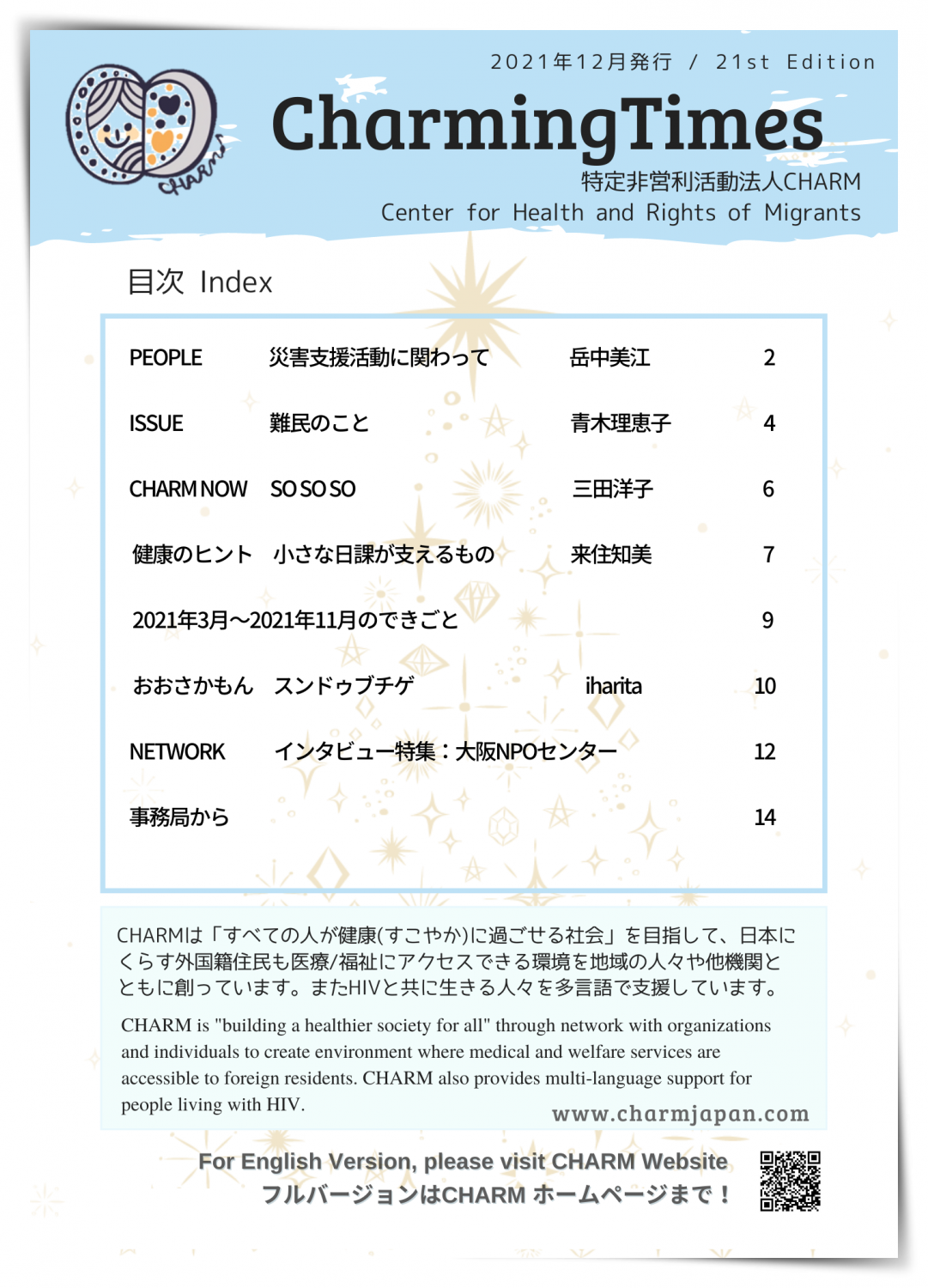
目次・Index
PDF版をダウンロードしていただけます
⇒ Charming Times No.21 (PDF)
English Version
English version Index
-PEOPLE-
災害支援活動に関わって
岳中美江
大阪を離れて、早や5年半が経ちました。郷里の熊本に戻って1週間後に熊本地震が発生したため、必然的に災害支援活動に関わり、そうこうするうちにコロナ禍の世になり、県外への移動自粛の時期が長く続き、大阪にも気軽に行けなくなってしまいました。そんな中で、2020年(令和2)年7月豪雨災害が発生し、被害の大きかった県南で活動を継続しています。
熊本地震が発生して、まず気になったのは、HIVとともに生きている人たちが薬を持っているのか、薬が足りない人への対応は可能なのかということでした。また、避難所で居心地を悪くしているセクシュアル・マイノリティの人がいるのではないかということも気がかりでした。HIV陽性の人たちに関しては、知り合いを通じて、HIV診療の中心を担っている拠点病院が安否確認していること、薬の確保も大丈夫そうだと把握することができました。何かしらの活動をしたいと思った私は、地元の通訳関係の仲間から情報を得てアメリカ拠点の緊急支援NGOの活動に参加しました。それは紛争地帯や自然災害の起こった地域で医療や衛生面に重点を置いた緊急支援をしている組織です。リーダー(たまたまゲイだったこともめぐり合わせ!)に、避難所などでのセクシュアル・マイノリティの人たちの心配や何ができるか相談したところ、緊急期のニーズは、被災した人たちがゲイであろうがそうでなかろうが共通しているものが多い、現段階ではそこにフォーカスし、後に個別に声を拾う必要があるとアドバイスを受けたことを覚えています。緊急支援のことを学びつつ活動し、このNGOが撤退した後の長期的な支援の継続性を感じました。 集まっていた多様なメンバーが地元の復興に向け長期活動をしようという思いを共有し、もともとあったバルビーのNPO法人化を経て、現在まで活動しています。また、被災者支援の調整を担う中間支援NPOの運営にも携わっています。
- 熊本地震:緊急支援時の仲間
- 2000年7月豪雨災害:球磨村災害ボランティアセンターのニーズ調査時
ずっとHIV関連の活動をしてきて、もちろん災害支援は初めての経験でした。しかし、あるとき、被災した人や地域に向き合うときの姿勢や大事にすることは、HIV関連の活動で大事にしてきたことと同じ、畑が違うだけだと気付き、気持ちが楽になりました。
災害により潜在的な社会課題が浮き彫りになり、拡大すると言われます。そしてHIV陽性者がひとくくりではないように、災害による影響を受けた(る)人も同じです。社会に声をあげにくい人たちや情報を得にくい人たちが災害によりさらにダメージを受けがちで、行政を含む関係組織で得意な分野や力を合わせてそのダメージや生きづらさを軽減する必要があります。一つの団体では限界があることでも、同じ目標を共有し、協働することができれば課題解決に向けた強い力になります。災害が、誰もが暮らしやすい地域への変身の機会にもなり得ると思っています。こういったことも、まさしくHIVの活動と共通していると感じています。CHARMをはじめ大阪で経験してきたことが、すべて今につながっています。
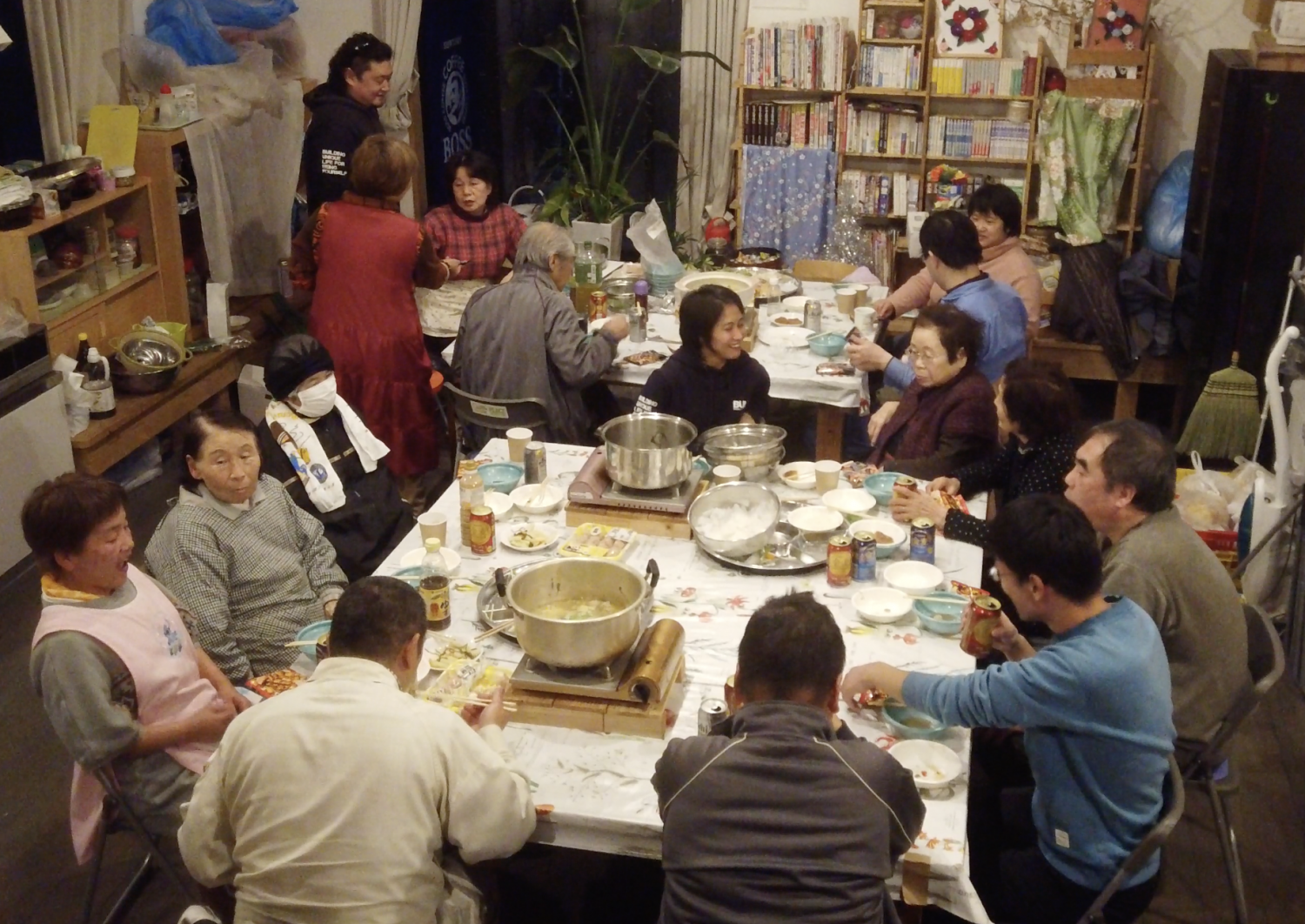
熊本地震:益城町の仮設住宅にて毎月の誕生日会
被災地の状況をはじめ、熊本地震や豪雨災害での活動など、興味がある方はホームページ、Facebook、Youtubeでバルビーの活動動画を見ていただくことができます。
Web : http://bulby.net/
Facebook : https://fb.com/npobulby/
Youtube : https://www.youtube.com/c/officeBulby
Instagram : https://www.instagram.com/bulby_jp/
-ISSUE-
難民のこと
青木理恵子
CHARMは、設立の時からHIV陽性者の個別の相談を受けています。コロナ禍でその様相が大きく変わりました。相談の中で難民申請者に出会ったことです。
難民とは、「紛争や人権侵害などから自分の命を守るためにやむを得ず母国を追われ、逃げざるを得ない人たち」*1 を言います。CHARMが出会った人の中には、家族が過去の政権の元で重要な立場であったために政権が代わった後に命を狙われその脅威が家族にも及んでいる人と、部族間の衝突で村全体が焼き討ちに合い母親と妹を殺された人がいます。
なぜ日本に来たのかということについては、日本は国連が1951年に制定した難民条約を1981年に批准したため難民を保護する国の1つとなっているからです。命の脅威を感じている人は、言葉が通じなくても、知り合いがいなくても出国します。
難民申請者の存在はマスコミで大きく取り上げられることが少ないため、この人たちが日本で生活していることを知ることは日常的にはないかもしれません。しかし、1979年から受け入れたインドシナ難民(ベトナム、ラオス、カンボジア)の後も世界で起こっている紛争や人権侵害のために難民として保護を求める人の来日は続いています。
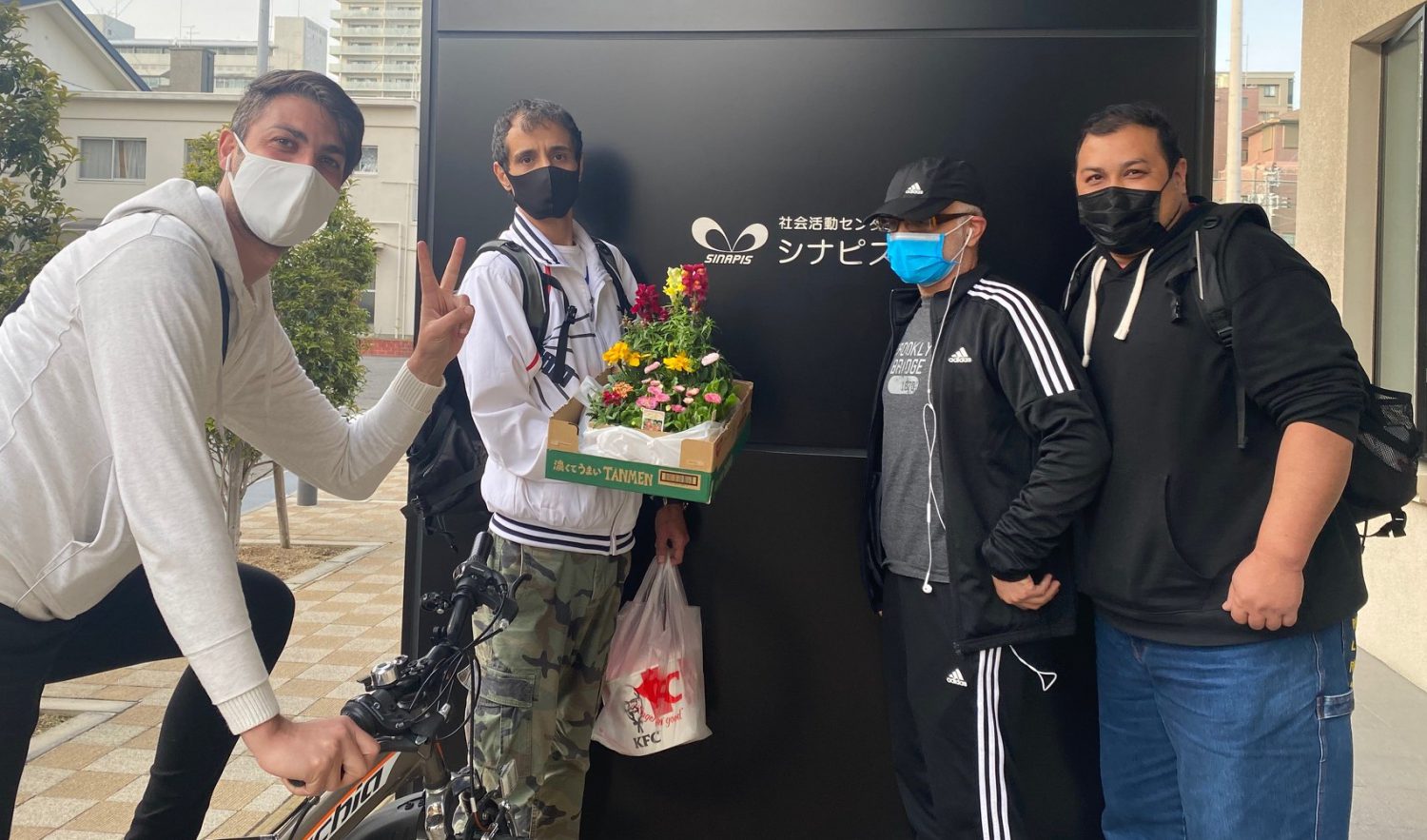
シナピスの活動より : 花壇にお花を植えに行きます!
2020年の日本の難民認定数は47人で認定数は0.5%でした。他の国の認定数と比べるとカナダが55.2%、イギリスが47.6%、ドイツが41.7%、アメリカが25.7% *2で認定率では日本と50-100倍の差があります。
日本に入国した難民申請者は、入国管理局で難民申請の書類を提出し数々の聞き取りと審査を受けます。結果が出るまでの期間は未定。その間、月1度入国管理局に出頭し、在留許可のハンコをもらいます。行動は自由ではなく、県外に移動する際には毎回入管の許可を得る必要があります。生活はというと、仕事をすることも健康保険に加入することも許されないため、親族や支援団体の援助を受けて、毎日生き延びるしかありません。家賃と最低限の生活費を国が援助する制度はありますが、申請して許可がおりるまでに時間がかかるため、その間に食べるものもない状態になる人もいます。健康状態が悪くなった場合は、医療費を一旦立て替えて後から払い戻してもらうため、立て替えるお金のない人は医療を受けることができません。
難民申請者の審査は、出入国在留管理庁が行っており、難民という特殊な事情で保護されるべき対象であるということが理解されません。そのため入管収容所への収容の対象にもなり、家族と離れて収容されることも、時には命が脅かされている国に強制送還されることもあります。保護を必要とする人を大切に扱う社会は、誰もが安心して生きることが可能な社会です。
*1 難民支援協会 https://www.refugee.or.jp
*2 Ibid 同上
●CHARMが連携している難民支援団体
大阪カトリック大司教区 社会活動センター シナピス https://sinapis.osaka.catholic.jp
●署名(change.org)への協力お願いします。
コロナ禍で苦しむ移民・難民の命を守る制度を整えてください!
https://www.change.org/EmergencyMedicalAid
-CHARM NOW-
SO SO SO
三田洋子
新しいプログラム「SO SO SO」が始まりました
SO SO SOとは、陽性者の方と周りの方のためのメール相談サービスです。メールで頂いた相談をコーディネーターが受け止めます。希望に応じて専門職、医療従事者、カウンセラー、HIV陽性者の方が相談にのります。パートナーや家族の相談にも応じます。利用は無料です。
今やエイズは慢性疾患の一つであり、ARV療法を継続することで、結婚や出産も可能です。HIV陽性者が普通に暮らす日常は、もう目の前なのかもしれません。
しかし、HIV 陽性者に対する情報や相談先が増えたように見える中でも相談しにくい方は潜在的に多くおられると思います。その人たちが何時でも繋がりやすい相談の方法としてメールで相談できる窓口を設置し、10月からオープンしました。
相談の内容に関しては、
①感染告知を受け、これからどうなるのか
②上司や家族に病気のことを話すべきか
③職場で差別的な扱いを受けた、どうしたらよいのだろう
④依存症から解放されたい
⑤HIV陽性者の人のパートナーとしてどう支えたら良いだろうか
⑥一人暮らし、将来、高齢者施設などに入所できるだろうか、
など色々な悩みを抱えておられることを想定しています。どうぞ誰にも言えずに心に蓋をしている方、一度SO SO SOへメールしてみませんか。きっと1歩踏み出せる。そう信じています。
-健康のヒント-
小さな日課が支えるもの
来住知美
コロナ禍で、ジョギングが流行っているらしい。そんなウワサをきいて最近、朝のジョギングを始めた。小学校の1500m走で心臓が飛び出る思いをしてから、自分は一生走ることに縁がないと思っていたのに、だ。いざ走り始めてみると初日は案の定、散々だった。息は上がるし、なぜか体がかゆくなる。しまいには途中で歩き始める始末。しかし数カ月が経った今、だいぶん楽に走れるようになった。まだ長い距離を走ることはできないし、至極ゆっくりとしたスピードだ。日課というにはサボりすぎだし、習慣と呼ぶにも程遠い。でも持病の肩こりがましになり、体が軽くなった実感がある。何より、朝焼けを見ながら汗をかくのはとても気持ちがよいものだ。
朝の公園にはいろんな人がいる。どこぞの大会Tシャツで颯爽と走る男性、手をつないで歩く仲睦まじい初老のカップル、やんちゃ盛りの柴犬を連れた女性、そして必ず出会うのは、車いすで現れる親子である。白髪の男性が車いすから立ち上がり、うつむき加減にゆっくりと一歩一歩、足を進める。脳梗塞か何かの病気で、体が動かしにくいのかもしれない。後ろから息子さんと思しき男性がそっと見守っている。彼らにとってこの毎日の小さな挑戦はどんな意味をもつのだろう。もしかすると「今日も散歩に出かけられた」という日常の積み重ねが、彼らの自信であり心の支えかもしれない、などと想像する。
思えば日課は、「健康」のバロメーターのひとつかもしれない。健康というと清廉潔白、教科書的なイメージだが、本来は個々人が定義するもっと生々しいものだと思う。つまずいたときや弱ったときほど、小さな日課が支えになる。今朝もまた窓を開けて気持ちのよい風を感じた、友人家族とやりとりができた、一杯のあたたかいお茶を飲めた…。その日常こそがその人の「健康」ではないだろうか。さらには困ったときに相談できる人、助けを求められる場所を知っていることも健康を支える力のひとつだろう。人生は順風満帆ではない。でも、どんな病(やまい)や挑戦を持っていようと、常にマイナスを数えるのではなく、時にはプラスを数えることが力になるのではないだろうか。
なお、つい先日、酔った勢いで来春のハーフマラソンに応募した。しかしながら食欲の秋と読書の秋を堪能し、私の体は重くなる一方である。まぁこれもまた小さな日常のひとつなので良しとするか…。
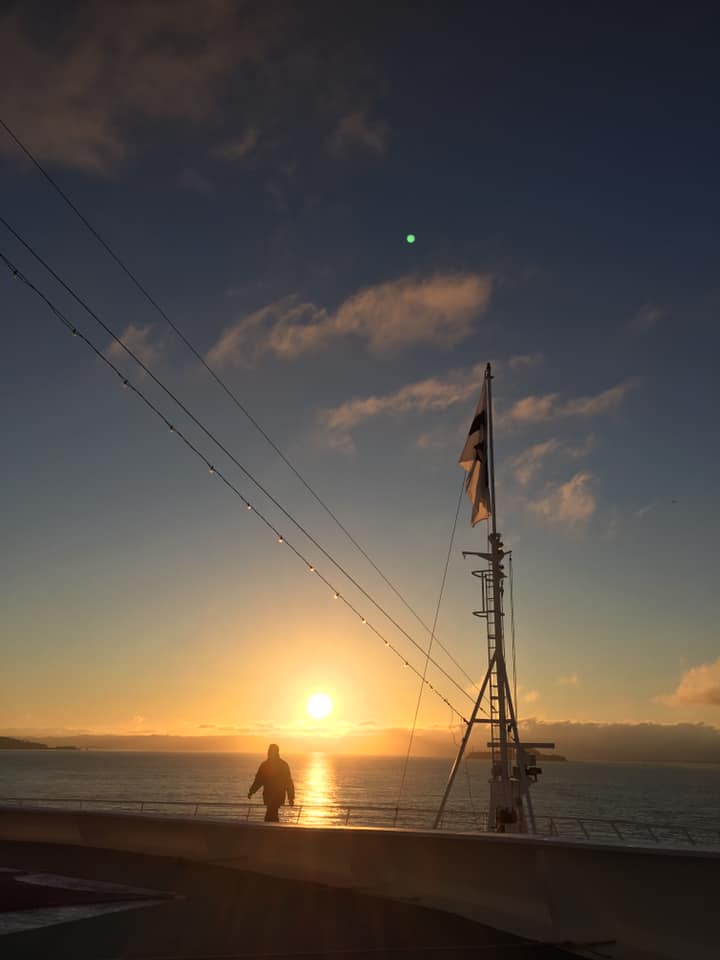
-おおさかもん-
スンドゥブチゲ
iharita
今回のおおさかもんはスンドゥブチゲのレシピを2種類紹介します。1つ目は韓国をルーツに持つ方の簡単濃厚スンドゥブチゲ、2つ目はテレビの料理番組で見たものを更にアレンジしたなんちゃってあっさりレシピです。以前よく通っていた韓国料理屋は頻繁に料理人が変わり、スンドゥブチゲが作り手によってとても違うことに驚きを感じました。毎日のように食べる副菜ですので、家庭ごとに大きく違うのだと思いますが、日本の味噌汁以上に味が違うように思いました。皆さんが自分流に味を変える参考にしていただければと思います。
一度本場のスンドゥブチゲも味わってみたいです。早く新型コロナウイルス感染症におさまってもらわなくては。
●本場の簡単濃厚スンドゥブチゲ
<材料> (2~3人前)
豆腐(絹ごし) 350g
あさり 250g
豚肉 150g
キムチ 150g
玉ねぎ 半玉
エノキ 1パック
白ねぎ青い部分 少々
春菊 少々
卵 1個/1人
水 500 ㏄
ダシダ 小さじ1
ナンプラー 小さじ1
イカの塩辛 小さじ2
仕上げにごま油 小さじ1
(★A) おろしにんにく2かけ、おろししょうが1かけ、白ネギの白い部分7㎝ (5ミリ幅に切る)、唐辛子お好みで、コチュジャン小さじ1、酒大さじ1、みりん小さじ1.5、しょうゆ小さじ1、サラダ油大さじ1
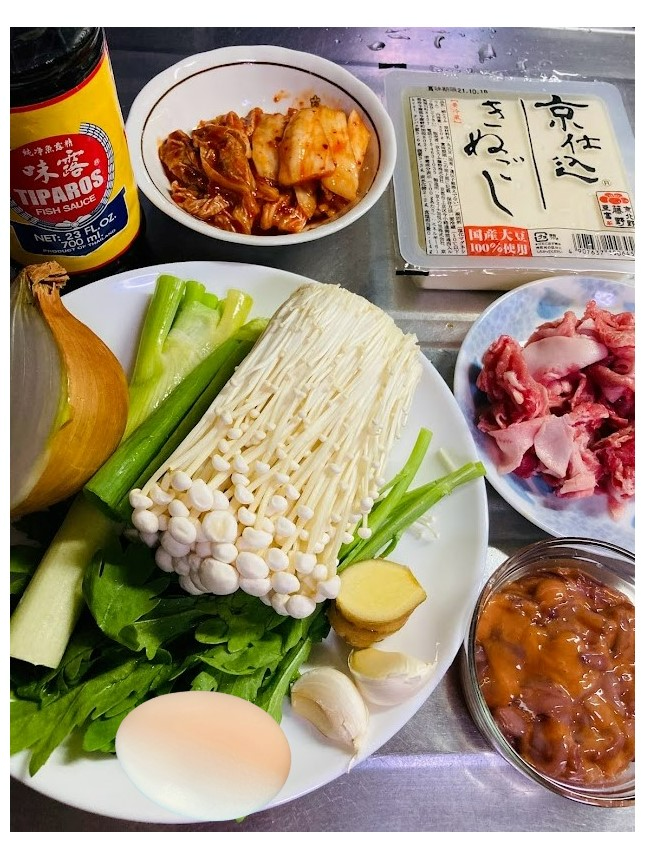
本場の簡単濃厚スンドゥブチゲの材料
~作り方~
① あさりを1時間ほど塩水につけて砂抜きをする。
② 鍋に食べやすい大きさに切った豚肉、キムチと上記★Aを加えて揉みこみ15分ほどつけておく。
③ その間に玉ねぎ、エノキ、白ネギの青い部分、春菊をカットしておく。
④ ②を火にかけて焦がさないようにじっくり炒める。豚肉に火が通ったら玉ねぎを加え更に炒める。
⑤ 水500㏄、ダシダ、ナンプラー、イカ塩辛を入れ、沸騰してしばらくしたら、エノキ、あさりと豆腐をスプーンで大きめにすくって入れしばらく煮る。
※ナンプラーやイカ塩辛を入れない場合は、味見をして塩加減を調整する。
⑥ あさりの殻が開いたら、真ん中に卵を落としネギの青いところと春菊で彩り、ふたをして卵がお好みの硬さになったらごま油を回しかけて出来上がり。
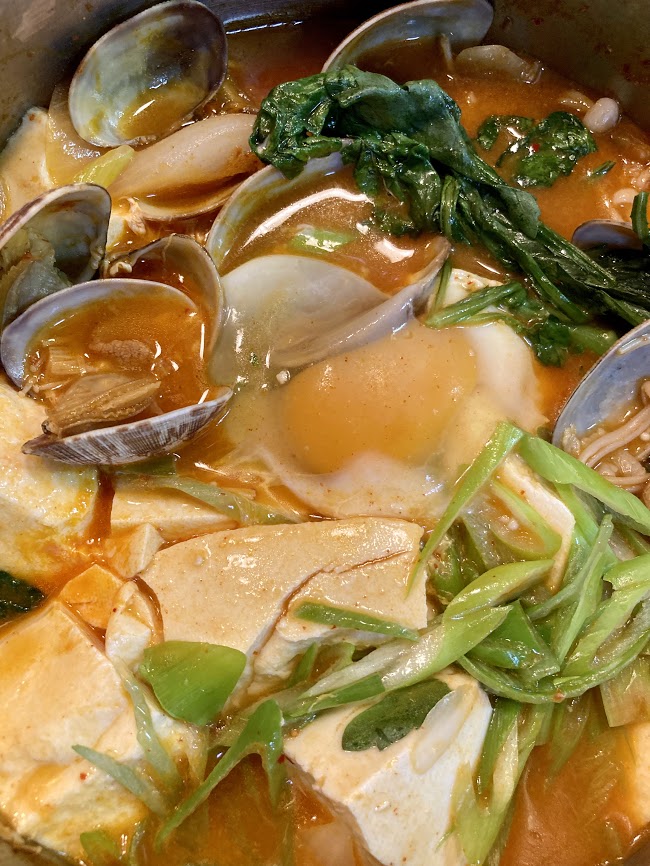
本場の簡単濃厚スンドゥブチゲ出来上がり!
<ここがポイント!>
つけておいた豚肉やキムチをじっくり炒めてオイルに風味を移すと、スープにとろみが出て濃厚になり、食べるときにスープと具が絡んでおいしいよ(^^) / 仕上げのごま油でおいしさアップ!
●あっさりレシピのスンドゥブチゲ
<材料> (3~4人前)
スンドゥブ(純豆腐/おぼろ豆腐) 1丁
(※絹こし豆腐で代用可)
あさり 350g
豚バラ 180g
韓国カボチャ(ズッキーニで代用可) 1本
白菜キムチ 200g
韓国青唐辛子 1 本
水 900 ml
コチュジャン 大さじ山盛 3
味噌 大さじ山盛 2
すりごま
ごま油
サラダ油
- あさりの口があくまで炒めましょう!
- あっさりレシピのスンドゥブチゲ出来上がり!
~作り方~
① あさりの砂抜きをして、粗塩などで洗っておく。
② 豚バラ、韓国カボチャ、白菜キムチ(最後に風味づけに足すために、4分の1程度と漬け汁を
残しておく)を食べやすい大きさに切っておく。
③ 鍋にごま油、サラダ油各大さじ1を入れて、①のあさりの口があくまで炒め、②を加えて
さらに炒める。
④ 豆腐をつぶしながら入れる。
⑤ 水を入れ、唐辛子を3つくらいに切って入れる。
※大きめにしておくと、食べられない人は見つけやすい。
⑥ 煮立ったら、コチジャンと味噌を入れてさらに煮る。
⑦ 味を見て、必要であれば塩などを足す。
⑧ 野菜が煮えれば、最後に残したキムチと汁、すりごまを入れ、混ぜたらできあがり。
<一言>
玉ねぎ、ジャガイモ、白菜などの残り野菜、干し貝柱、あさり以外の貝を入れてもおいしいです。韓国カボチャは韓国総菜屋さんで売っているので、是非一度お試しあれ。シシトウとジャコの炒め物(炒めて、しょう油、みりん、砂糖などで味をつける)やナムル(わたしはアボカドと香草を適当に切って、ごま油、酢、塩、すりごま、一味であえたものが好きです)などを足せば、韓国定食(メインがないですが)の気分が味わえます。マシケジュセヨ(おいしく召し上がれ)。
-NETWORK-
インタビュー特集:大阪NPOセンター
CHARMと関わりのある団体/組織について紹介する当コーナー。今回は「認定特定非営利活動法人大阪NPOセンター」を紹介したいと思います。現在、大阪NPOセンターが実施されているNPOの事業運営支援講座にCHARMが参加していますが、多くを学び、助言を得る貴重な経験をしています。大阪NPOセンターの活動やこの講座を実施している理由、しかも海外で支援を行っているJICAと協働しているのはなぜ?の疑問をもったことが最初でした。
インタビューを受けていただいたのはスタッフの大友康博さんと石地恵里子さんです。
●大阪NPOセンターの活動について教えて下さい。
石地:設立した当初から民間の中間支援機関として、裏方である「黒子(くろこ)的」な活動をしています。組織運営、事業運営について、何らかの課題を抱えている団体(組織)が課題解決、改善できるようにサポートをしています。
大友:当団体は自ら社会課題解決を行うのではなく、中間支援機関として、新たに社会的課題に取り組む団体を立ち上げるお手伝いや、課題に取り組んでいる団体の運営をサポートしています。そのため、幅広い知識、技術が必要です。福祉、環境など特定の分野に限定せず、どの分野の団体でもサポートしたいと考えています。
・団体設立は、阪神淡路大震災が発生した翌年の1996年に、当時の大阪青年会議所のメンバーが、社会課題解決に取り組む団体を持続的にサポートする組織が必要だと考え、設立されました。なお現在、当団体に勤務するスタッフの多くが、過去にNPOや社会的活動をしてきた者ではなく、企業や大学に勤めていた者である、というのも一つの特徴です。
・国際化対応については、これまで支援してきたNPOやソーシャルビジネス団体が国際化対応や海外の課題に取り組むようになったため、当団体としてもチャレンジするようになり、最近ではJICAと協働して事業を行うようになりました。
●現在JICAと協働で行っている「創業期にあるNGO等の事業運営支援講座」について
大友:JICAは「海外移住事業団」と「海外技術協力事業団」が統合され、発足された事業団です。海外への技術協力が目立ちますが、日本国内のNGO支援も行っています。現在、CHARMさんが参加している「創業期にあるNGO等の事業運営支援講座」の事業は当団体がJICAの「NPO提案型事業」に応募して受託したものです。JICA関西との協働は、2017年度から2019年までの「国際協力NGO等の中長期事業運営、組織運営サポート事業」(委託事業)から始まりました。その事業内容は、多くのNPOが目前にある課題に一生懸命取り組んでいるため、単年度で物事を考えがちになります。しかし、中長期的な視点を持って運営していけるように、まずは、中長期ビジョンの策定を支援します。次にそのビジョンに沿った一年単位の事業計画を策定することを勧めました。事業成果としては、参加したNPOの多くが、中長期的な観点で事業運営、組織運営を検討、計画化することができるようになったと思います。
・現在も引き続きJICA関西と協働で、「創業期にあるNGO等の事業運営支援講座」を行っています。これから国際協力/国際交流に関する事業を始めようとしている新しい団体や、活動が長い団体であっても、第二創業として新たな国際協力/国際交流を行うNPOに受講していただき、支援をしていきます。
・受講することで他団体との交流ができ、刺激やヒントを受けることができると思います。
石地:当講座は研修を受けていただいた後に、経営支援を行います。具体的には、講師(NPOの運営支援の実績がある中小企業診断士)と事務局職員が受講団体の職員とともに、運営課題を見つけ、その解決、改善に取り組んでいきます。「研修プラス経営支援」により、とても団体に役立つ、実効性の高い研修プログラムであると思います。
この「創業期にあるNGO等の事業運営支援講座」事業は2021年9月からスタートし、現在7団体が受講しています。引き続き、受講団体を募集しています。
http://osakanpo-center.com/gallery/gallery_detail.php?g_id=103
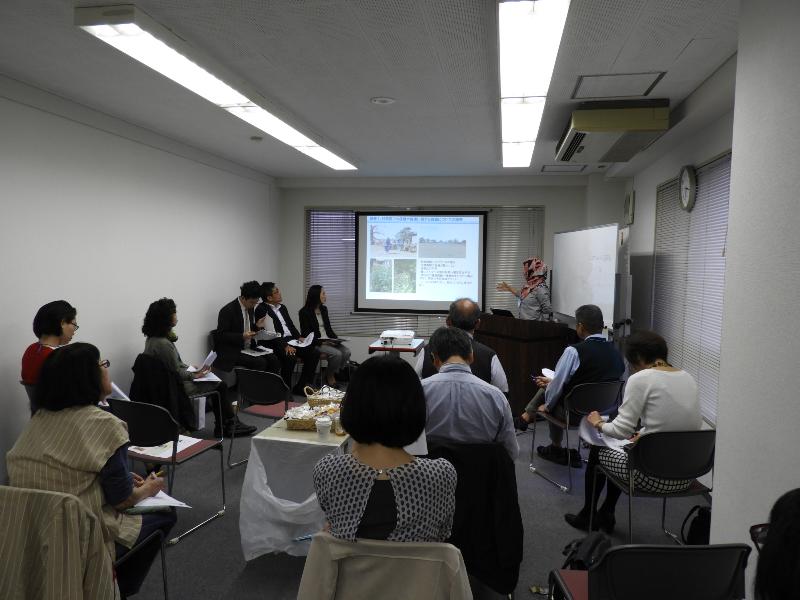
<インタビュー後記>Charming Timesの紙媒体に載せきれないインタビューの続きをどうぞ。
●お二人が感じるNPOにおける働き方/関わり方について
石地:時代の変化がありました。以前は学校を卒業してNPOで働くことは難しかったですが、現在は「社会貢献」「SDGs」などの言葉が浸透し、様々な方がNPO設立や運営に関わるようになってきました。今後も、例えば、会社勤務しながら「複業」という形など、これまでにない形態でNPOに関わる人が多くなるのではないかと思います。
大友:働き方改革によって、企業に勤務しながら、就業時間外では、NPOとの兼業/副業や、社会貢献/SDGsの活動を容認する、という流れになっています。以前、研修を受講されていた団体の中に、平日は会社員をして、メンバーが休みを合わせて国際協力活動していた団体もありました。今後も企業の就業時間外に自由に社会的活動をする時代になっていくのではないかと思います。
●日本の国際協力NGOは東京に集中している
大友:日本の国際協力NGOの多くは東京圏に集中しています。今後とも、関西を含む地方で国際協力を行うNGOをもっと創出していきたいという思いがあります。
●事業の課題について
大友:この事業にも予算に限りがあるため、本当はもっと多く時間をかけて経営支援を行いたいのですが、それができないことです。また、この事業実施の期限もあります。今のうちから、その後を見据えて、受講団体同士の横のつながりを促進したいです。受講団体同士の「共創・協働」を促したいです。そして、当団体がこの事業が終了しても、何らかの収入を得て、継続していきたいと考えています。さらに、受講団体の多様な支援ニーズに対応できるよう、支援スキルの向上も必要です。今後、コロナウィルス感染が落ち着いたら、実際の活動現場を見て、一緒に状況を確認し、専門家と受講団体とともに、団体の抱える課題解決、改善を行いたいと思います。
石地:本事業が終了した後のその先を見据える必要があります。また、各団体の経営課題は、時間の経過に伴って変化するため、真の経営支援ニーズがどこにあるのかを見極める必要があります。可能な限り、現場で経営支援ニーズを把握したいと考えます。
(聞き手:ポップ)
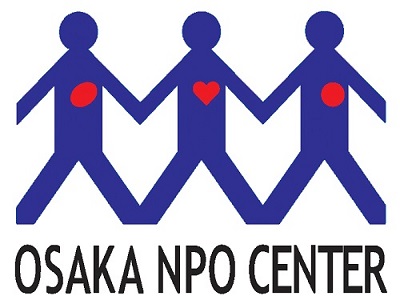
【連絡先】
認定特定非営利活動法人 大阪NPOセンター
http://osakanpo-center.com/contact.php
-2021年3月~2021年11月のできごと-
6月12日 会員総会(オンライン)
6月14日,29日 大手前大学国際看護学部講師派遣
6月23日 大手前大学国際看護学部講師派遣(オンライン)
7月13日,20日 大手前大学国際看護学部講師派遣
7月26日~30日 大手前大学国際看護学部実習受け入れ
8月 7日 医療通訳研修(第1回)
9月 4日 医療通訳研修(第2回)
10月2日 医療通訳研修(第3回)
10月20日 大阪医療センタードクター研修受け入れ
10月27日 大阪市感染症対策(結核)にかかる保健師研修講師派遣(オンライン)
10月30日 医療通訳研修(第4回)
11月21日~23日 日本エイズ学会(東京)
●定例のオンライン集会
・Social Connection-つながり-
開催日:3/13、4/10、5/8、7/10、8/14、9/11、10/9、11/13
・Cooking with Japan’ease
開催日:4/21、5/19、6/16、7/28、8/18、9/15(終)
・女性交流会
開催日:4/23、6/26、8/28、10/30
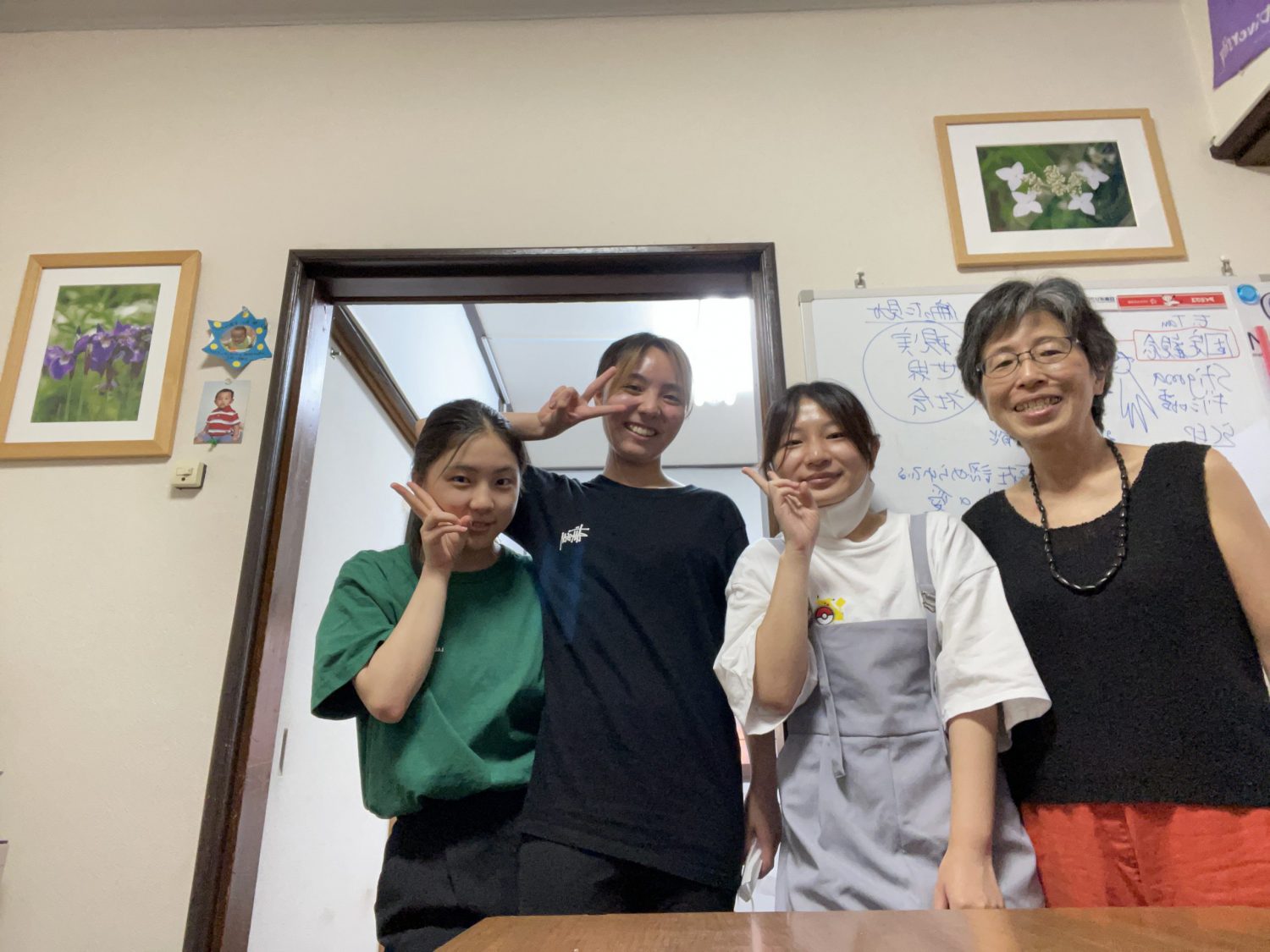
大手前大学国際看護学部実習生とスタッフ
-事務局から-
CHARMの活動に参加しませんか?CHARMはともに活動する人々をCHARMER (チャーマー)と呼んでいます。
それは支援する、支援されるという枠や立場を超えて、みんなで「すべての人が健康に過ごせる社会」を目指したいからです。 あなたもCHARMER (チャーマー) になりませんか!
*CHARMER(チャーマー):会員をはじめ、事業メンバー、プログラムスタッフ、ボランティアなど、CHARMで活動に関わっているすべての人の総称です。
●会員になる (費用は4/1〜翌3/31までの1年間)
・サポーター(賛助員)A (Supporter A) 3,000円
・サポーター(賛助員)B (Supporter B) 5,000円
・団体/法人サポーター 1口 (Corporate Supporter) 10,000円
正会員についてはCHARM事務局までお問い合わせください。
●会費・寄付をクレジットカード決済できます。
上記の銀行振り込み以外に、コングラント(congrant)経由でCHARMへの会費・寄付をクレジットカード決済ができるようになりました。ご都合のいいお支払い方法を選んでください。
*会費も寄付も自動決済ではなく、その都度、お手続きしていただく必要があります。
English Version
Index
-PEOPLE-
Taking a part in disaster response
Mie Takenaka
I came back to my home town Kumamoto 5 and half years ago. I can’t believe it has been so long since I left Osaka. I miss it very much! Right after I came back to Kumamoto, big earthquakes happened and it was very natural for me to be involved in activities to support people affected by the disaster. The COVID-19 pandemic impacted our lives as well as support activities, while another disaster by heavy rain happened in Kumamoto last year.
When the earthquakes happened and many people were evacuated in safer places such as school gyms and community centers, I became worried about people living with HIV. Do they have enough medications? Do they have access to hospitals? I called people around and found out that the core hospital made contact with their patients to make sure they are safe and have medications. I also was worried about if sexual minorities have places they can feel safe and comfortable.
I started to work with an international NGO which was specialized in emergency response focusing on sanitation and medical care in areas affected by disasters and conflicts. The leader happened to be a gay man and I could consult about my worries about sexual minorities. As I was involved in emergency response, I realized that this NGO won’t stay long in Kumamoto but the support for the affected would be needed for a long time. Local members got together to continue the support work in Kumamoto, established NPO and still active to support people affected by the earthquakes and flood.
- 熊本地震:緊急支援時の仲間
- 2000年7月豪雨災害:球磨村災害ボランティアセンターのニーズ調査時
It was my first time to work with people affected by disasters since I have been working in HIV related field all my life. However, I realized that the way I work with people and communities can be the same as before.
Disasters reveal and expand social issues. As people living with HIV are all different, people affected by disasters are all different. People who have less access to information and who have harder time to voice may be damaged by disaster more. Supporters including government have to work together to reduce those damages. One organization may have limits but collaboration by sharing the same purpose can create strong power for solving issues. I want to believe that a disaster can be an opportunity for a society to change for the better, a society that everyone can comfortably be. Same thing for HIV. Every single thing I experienced in Osaka including CHARM are linking to my current life.

熊本地震:益城町の仮設住宅にて毎月の誕生日会
Web : http://bulby.net/
Facebook :https://fb.com/npobulby/
Youtube:https://www.youtube.com/c/officeBulby
Instagram : https://www.instagram.com/bulby_jp/
(Translator: Mie Takenaka)
-ISSUE-
Refugees
AOKI Rieko
Since its foundation, CHARM has offered consultation with individuals who are HIV positive. When the coronavirus pandemic started, we faced a totally different situation than before, which changed the conditions of these consultations. This includes meeting people who are applying for refugee status at the immigration office.
Refugees are defined as “people who have fled their country in order to protect their lives from wars and human rights violations” [1]. The people CHARM has encountered include those with family members who once held important posts in their countries but lost these positions. Therefore, when the government changed, their entire family were forced to live in a life threatening situation. Some have had family members actually assassinated.
The reason they came here is because Japan is one of the countries that protects refugees since ratifying the Refugee Convention in 1981. The Refugee Convention was established by the United Nations in 1951. People who feel their lives are in danger leave their countries and go to a safer place, even if they don’t know the language or have any acquaintances there.
Not many Japanese know that applicants for refugee status are living in Japan. People from around the world continue to come to Japan to seek protection as refugees due to conflicts and human rights violations.

シナピスの活動より : 花壇にお花を植えに行きます!
In 2020, the number of refugees recognized in Japan was 47, which is 0.5% of the total applicants for refugee status. The recognition rates in Canada, the United Kingdom, and Germany are 50 to 100 times higher than Japan’s.
When applicants for refugee status enter Japan, they submit application documents to the immigration office and undergo a number of hearings and examinations. While waiting for the results, they have to appear monthly at the immigration office and receive the stamp for residential permission. Applicants for refugee status are not allowed to travel freely. Every time they need to go outside of the prefecture where they live, they have to obtain permission from the immigration office. They are not allowed to work or have health insurance. Because of this, they have to survive with support from their relatives or support groups. There are programs offering financial assistance for rent and minimum cost of living stipends from the Japanese government. However, since it takes some time to get permission to use these programs after applying for them, there are people who cannot even afford to buy enough food. Furthermore, when they become ill, they cannot seek medical help because they cannot pay for it.
Examinations of applications for refugee status are handled by the Immigration Services Agency. The fact that refugees should be protected due to their specific life threatening condition is not well understood. Therefore, they become subject to being held in detention centers, sometimes separately from their family members, and can be deported to a country where they face life threatening dangers. A society that can value people who need protection is a society where everybody can live safely.
Refugee support group cooperating with CHARM
Community Activity Center Sinapis, Catholic Archdiocese of Osaka
https://sinapis.osaka.catholic.jp
[1] Japan Association for Refugees https://www.refugee.or.jp
●Signing campaign
Don’t make the poor pay for expensive medical bills!
Campaign at change.org
(Translator: YAMAGUCHI Mikiko)
-CHARM NOW-
SO SO SO
YOKO Mita
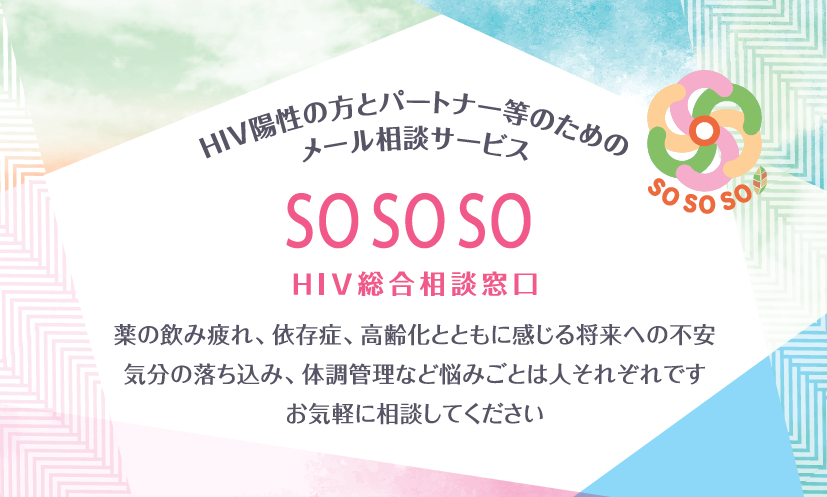
“SO SO SO” is an email consultation service for people who tested HIV positive and those around them. The coordinator will accept the consultation received by e-mail. You can consult with specialists, medical professionals, counselors and HIV-positive people, if you wish. Your partner or family can additionally consult with them, free of charge.
AIDS is now one of the chronic diseases, and marriage and childbirth are also possible by continuing ARV therapy. Normal daily life of HIV-positive people may be close at hand.
However, I think there are potentially many people who have difficulties consulting even though they can get more information or advice regarding this disease. So, we set up a window of consultation that is easy to access at any time. That is this email consultation service and it opened in October.
Contents of the consultation;
1. What will happen in the future after receiving the notification that I have tested positive?
2. Whether or not I should tell my boss or family about the disease.
3. What should I do if I am treated discriminatorily in the workplace?
4. I want to be free from addiction.
5. How should I support my partner who is HIV positive.
6. Will I be able to enter care facilities in the future if I become elderly and live alone?
We assume that you may have various problems as such, but you shouldn’t keep them in yourself. Why don’t you email “SO SO SO”? We can assist you in taking a step forward.
(Translator: TESHIMA Masao)
-Health Hint-
What a small routine can do
KISHI Tomomi
I heard that jogging is a popular activity in the Corona disaster. Hearing such talk, I recently started jogging in the morning. I had thought that I would never run again since I had a hard time running 1500m in elementary school. The first day I started running, my breath would come in gasps and my body would itch for some reason. Then I started walking halfway. A few months have passed since then. I can run much more easily now. I still can’t run long distances, and my pace is very slow. I can’t even call it a habit because I don’t do it every day. But my stiff shoulders, which is my chronic problem, have eased up and I feel lighter. Above all, it feels good to sweat while watching the morning sunrise.
There are many people in the park in the morning. There are men running briskly, an elderly couple walking hand in hand, women with dogs, and without fail, a man in a wheelchair and his child. The gray-haired man stands up from his wheelchair and slowly walks forward, step by step, looking down. He may have had a stroke or some other illness that makes it difficult for him to move. A man who looks like his son is gently watching him from behind. I wondered what this small daily challenge would mean to them. I imagine that the daily routine of “I was able to go out for a walk again today” may give them confidence and emotional support.
When I think about it, the daily routine may be one of the barometers of “health”. Health is a textbook image of clean and pure, but I think it is something more subtle and defined by the individual. The more you stumble or feel weak, the more a small routine can support you. This morning, I opened the window again and felt a nice breeze, I was able to communicate with my friends and family, and I was able to have a cup of tea. This daily life is the “health” of a person. In addition, knowing who you can talk to and where you can get help when you need it is one of the strengths that support your health. Life is not always smooth sailing. But no matter what kind of illness or challenge, it is always good to count the positives instead of counting the negatives.
Just the other day, I got drunk and applied for a half marathon next spring. However, my body is getting heavier and heavier as I enjoy the autumn of appetite and reading. Well, it’s just one of those little everyday things, so I guess it’s all good…

(Translator: Kate)
-Osaka mon-
Sundubu Jjigae
iharita
Here are two kinds of recipe for Sundubu Jjigae. One is a simple, thick, authentic one that has Korean root and the other, a light and easy recipe, which was aired in a TV cooking program and arranged to suit Japanese tastes. Why not give it a try to make whichever recipe you would like and arrange it to suit your taste.
● Sundubu Jjigae – A simple, thick, authentic.
~Ingredients ~ (2-3 servings)
350g silken tofu (Kinugoshi)
250g scallion (Asari)
150g pork
150g kimchi
Half an onion
1 package enoki mushrooms
A little green part of white leek
A pinch of garland chrysanthemum
1 egg / person
500 cc water
1 teaspoon dashida (Korean dashi)
1 teaspoon Nampra (fish sauce)
2 teaspoons Ika Shiokara(salted squid)
1 tsp sesame oil to be added at the end
(A) 2 cloves of grated garlic, 1 clove of grated ginger, 7cm white part of leek (cut into 5mm pieces), chili pepper to taste, 1 teaspoon gochujang (red pepper paste), 1 tablespoon sake, 1.5 teaspoons mirin, 1 teaspoon soy sauce, 1 tablespoon salad oil

本場の簡単濃厚スンドゥブチゲ
~How to make
1) Soak the scallions(Asari) in salted water for about an hour (to remove sand).
2) Add the sliced pork, kimchi, and *A above, rub in, and leave in the pot for about 15 minutes.
3) Meanwhile, cut onion, enoki mushroom, green part of white leek and garland chrysanthemum.
4) Put 2) on the fire and fry slowly so as not to burn. When the pork is cooked, add the onion and fry further.
5) Add 500 cc of water, dashida, Nampra and Ika Shiokara. Some time after this has boiled, add enoki mushroom, scallion and tofu (scoop out with a spoon) and simmer for a while.
* If you don’t add Nampra or Ika Shiokara, taste and adjust with salt.
6) When the scallion shells open, place an egg in the middle of the pan, and top with green leek and garland chrysanthemum, and cover with a lid. When the eggs have reached the desired consistency, drizzle with sesame oil and serve.

本場の簡単濃厚スンドゥブチゲ出来上がり!
~~This is the key!~~
When you fry the pork and kimchi slowly, the soup will thicken and become rich and strong, in which the ingredients are coated with the soup and become delicious. It tastes even better if you add sesame oil at the end!
●Sundubu Jjigae – A Light and Easy Recipe
~Ingredients ~ (3-4 servings)
1 tofu (tofu/oboro tofu) (silken tofu(Kinugoshi) can be substituted)
350g scallion (Asari)
180g pork belly
1 Korean pumpkin (zucchini can be substituted)
200g Chinese cabbage kimchi
1 Korean green chili pepper
900ml water
3 heaped tablespoons gochujang (red pepper paste)
2 heaped tbsp miso paste
grind sesame seeds
Sesame oil
Salad oil
- あさりの口があくまで炒めましょう!
- あっさりレシピのスンドゥブチゲ出来上がり!
~How to make
1) Remove the sand from the asari clams and wash them with coarse salt.
2) Cut the pork belly, Korean pumpkin, and Chinese cabbage kimchi (reserving about a quarter of the mixture and the pickling liquid to add flavor at the end) into bite-sized pieces.
3) Add 1 tablespoon sesame oil and 1 tablespoon salad oil to a pan and fry the scallions until they are tender, then add 2) and fry further.
4) Add the tofu, crushing it as you go.
5) Add water and chili (cut into 3 pieces).
* Cut them to a little bigger size, then it is easier for those who cannot eat them to find.
6) When it starts to simmer, add the gochujang and miso and cook further.
7) Taste and add more salt if necessary.
8) When the vegetables are cooked, add the leftover kimchi, kimchi liquid, and grind sesame seeds and serve.
~~A word~~
You can also add leftover vegetables such as onions, potatoes, Chinese cabbage, dried scallops, and shellfish other than scallions, which is also good. Korean pumpkin is sold at Korean food stores, so you should definitely give it a try. If you add some stir-fried shishito peppers and baby sardines (stir-fried and seasoned with soy sauce, mirin, sugar, etc.) or namul (I like avocado and herbs cut into pieces and mixed with sesame oil, vinegar, salt, grind sesame, and cayenne pepper powder), you can enjoy it like a Korean set meal, (but no main dish).
(Translator: MATSUOKA Ayako)
-NETWORK-
Interview:Osaka NPO Center
Here, we introduce the groups/organizations that are involved with CHARM. In this issue, you will learn about the Osaka NPO Center.
Mr. OTOMO Yasuhiro and Ms. ISHIJI Eriko
●Please tell us about the activities of the Osaka NPO Center.
Ishiji: Since our group’s establishment, we have been performing “behind the scenes” tasks as a private intermediate support organization. We provide support to groups/organizations that are facing some challenges regarding organizational and operational issues to help solve their problems and improve their operations.
Otomo: Our organization doesn’t directly solve social issues, but instead helps others to establish new organizations that work on social issues. We also support the operations of existing groups as an intermediary support organization. This requires a wide range of knowledge and skills. We are not limited to the welfare and environmental fields, but are willing to support any organization in any field.
・ The organization was established in 1996, a year after the Great Hanshin-Awaji Earthquake. One of the features of our organization is that many of our current staff members were not previously involved in NPO s or social activities but had been working for ordinary companies and universities.
・ Since the NPO s and social business organizations we’ve been supporting have started to get involved in international and overseas issues, we have become more international as well. Recently, we have started to work with JICA.
● Since you mentioned JICA, tell us about your collaboration with them in the “Course to Support NGO Project Operations in Their Start-up Phase”.
Otomo: JICA is an agency that integrates “Overseas migration” with “Overseas technical collaboration”. People mainly see their overseas technical collaborations, but actually, they support domestic NGOs, too. The “Course to Support NGO Project Operations in Their Start-up Phase” is a project JICA has entrusted us to do. CHARM is currently participating this course. Our collaboration with JICA Kansai started with the “Supporting Projects and Organizational Operations for Middle and Long Term Operations by NGOs for International Cooperation” (entrusted project) from fiscal year 2017 to 2019. A lot of times, NGOs work hard on the project in front of them with the concept of a single year of operation. However, we help them design their projects from the viewpoint of middle and long term operation, then plan each year’s operation keeping the original viewpoint in mind. As a result, we believe many NGOs have been able to run their projects, examine their organizational operations and plan these projects with middle and long term views.
・ We are continuing to conduct the “Course to Support NGO Project Operations in Their start-up Phase” in cooperation with JICA Kansai. We will allow NGOs to take their course and support new organizations that are starting projects involving international cooperation/international exchange, including those with long histories who are trying to start additional projects in these areas.
・ Taking the course will create opportunities to exchange information with other organizations by sharing ideas and hints with each other.
Ishiji: Each organization receives project support after they take the course. In detail, instructors (medium enterprise management consultants with actual NGO operational support experience) and members of our organization figure out operational issue with the members of organizations taking this course. Then, we’ll work together on solutions to improve services. We believe this is a useful and highly workable program to “train and support operations” for each organization.
・ The “Course to Support NGO Project Operations in Their Start-up Phase” began in September 2021 and 7 organizations are currently taking the course. We continue to look for other organizations to take this course.
http://www.osakanpo-center.com/gallery/gallery_detail.php?g_id=103

(Interviewer: Pop)
【Contact】
Osaka NPO Center
http://osakanpo-center.com/contact.php

(Translator: YAMAGUCHI Mikiko)


